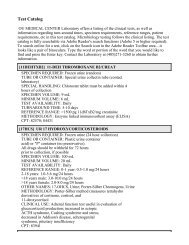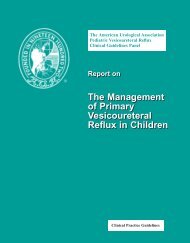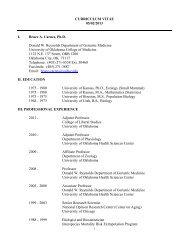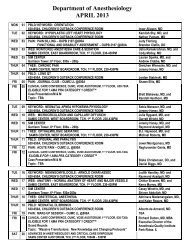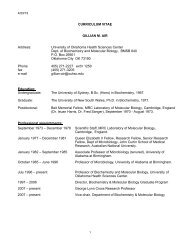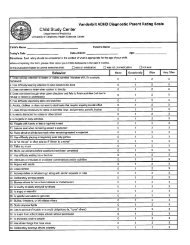Infant Security Processes â OU Medical System In ... - OU Medicine
Infant Security Processes â OU Medical System In ... - OU Medicine
Infant Security Processes â OU Medical System In ... - OU Medicine
You also want an ePaper? Increase the reach of your titles
YUMPU automatically turns print PDFs into web optimized ePapers that Google loves.
Now you are asking, what does a suspicious person look like?<br />
It is someone who may exhibit one or more of the following characteristics:<br />
• Makes repeated visits “just to see” the babies<br />
• Takes uniforms, scrubs, or other means of hospital identification as well as<br />
stethoscopes, pagers, etc…<br />
• Loiters on the floors where the perinatal and neonatal units are located and around the<br />
doors<br />
• Asks questions about the floor plans, location of nursery, procedures, etc.<br />
o For example – “Where do the stairwells lead?” or “Do babies stay with mother at<br />
all times?”<br />
• Carries a large package from the care area (e.g. gym bag), particularly if the person is<br />
“cradling” or “talking” to the bag<br />
• Carries an infant in a corridor instead of a bassinet<br />
• Walks out of the hospital with an infant rather than riding in a wheelchair with a staff<br />
member or volunteer escort<br />
The Abductor – Profile from the National Center for Missing & Exploited Children:<br />
• Is usually female of “childbearing” age (range now 12 to 53) and often overweight.<br />
• Is most likely compulsive; most often relies on manipulation, lying, and deception.<br />
• Frequently indicates she has lost a baby or is incapable of having one.<br />
• Is often married or cohabitating; companion’s desire for a child or the abductor’s desire<br />
to provide her companion with “his” child may be the motivation for the abduction.<br />
• Usually lives in the community where the abduction takes place.<br />
• Frequently initially visits nursery and maternity units at more than one healthcare<br />
facility prior to the abduction; asks detailed questions about procedures and the<br />
maternity floor layout; frequently uses a fire-exit stairwell for her escape; and may also<br />
try to abduct from the home setting.<br />
• Usually plans the abduction, but does not necessarily target a specific infant; frequently<br />
seizes any opportunity present.<br />
• Frequently impersonates a nurse or other allied healthcare personnel.<br />
• Often becomes familiar with healthcare staff members, staff members work routines,<br />
and victim parents.<br />
• Demonstrates a capability to provide “good” care to the baby once the abduction<br />
occurs.<br />
There is no guarantee an infant abductor will fit this description. This is only a profile. An<br />
infant abductor can be of ANY sex, age, or description including.. a hospital employee.<br />
Thank you for your time and attention to this<br />
important topic!



